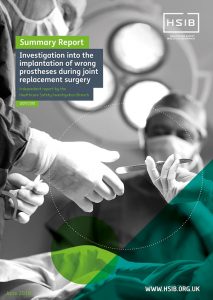 The Healthcare Safety Investigation Branch (HSIB) has published its first investigation report relating to a surgical never event.
The Healthcare Safety Investigation Branch (HSIB) has published its first investigation report relating to a surgical never event.
The patient is a 63-year-old man who underwent hip replacement surgery. During this surgery, incompatible components were used. The error was identified when data from the procedure was recorded in the National Joint Registry.
HSIB’s investigation centred on how the error occurred and what recommendations could be made to reduce the risk of a similar event happening again. The investigation team observed similar surgical procedures in England and in Denmark as part of the investigation process.
The investigation team worked collaboratively with organisations including the National Joint Registry, British Orthopaedic Association, NHS Improvement and the Department of Health and Social Care ‘Scan4Safety’ programme. The investigation and final report was based on reviewing existing data, observations in operating theatres, interviews and clinical subject matter expertise. The report makes five safety recommendations, and one safety observation to support staff and to improve patient safety.
Chief investigator, Keith Conradi, whose experience includes six years as the chief investigator of the Air Accident Investigation Branch, said
“This first report is the culmination of many months of rigorous and independent investigation, working closely with those involved in the incident, as well as relevant organisations and subject matter experts. Our independence allows us to make public safety recommendations to the healthcare sector, both within and outside the NHS. In publishing this report, we have made safety recommendations to the organisations who must act on them to improve patient safety. We will publish their response to the recommendations in the coming months on our website.”
This report is the first safety investigation report published by HSIB. There will be up to thirty investigations undertaken each year with safety recommendations published to mostly national bodies to ensure systemic learning that does not apportion blame or liability.
To view the summary of the report please click here
To view the report in full please click here
